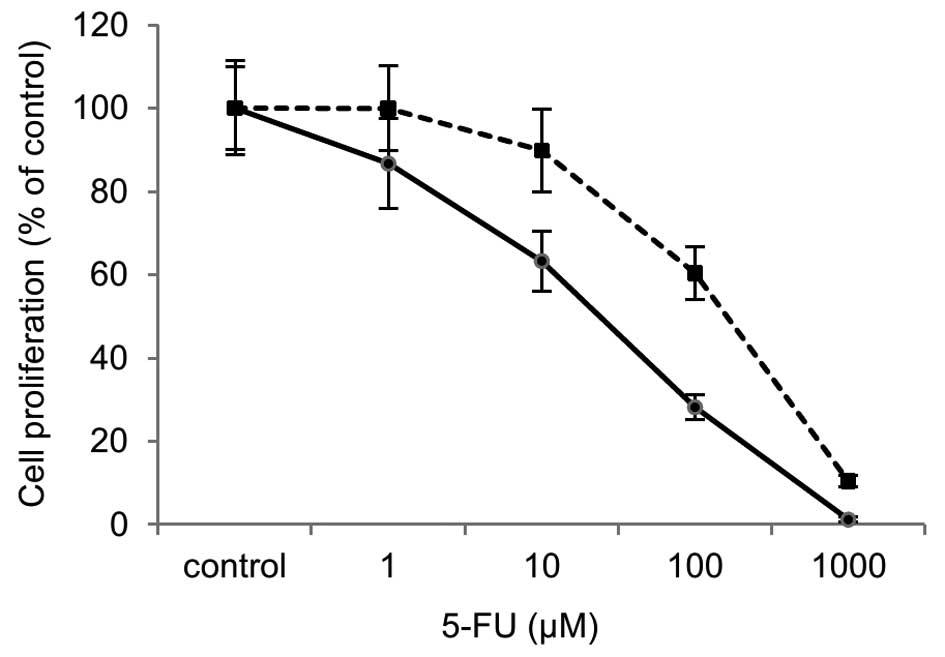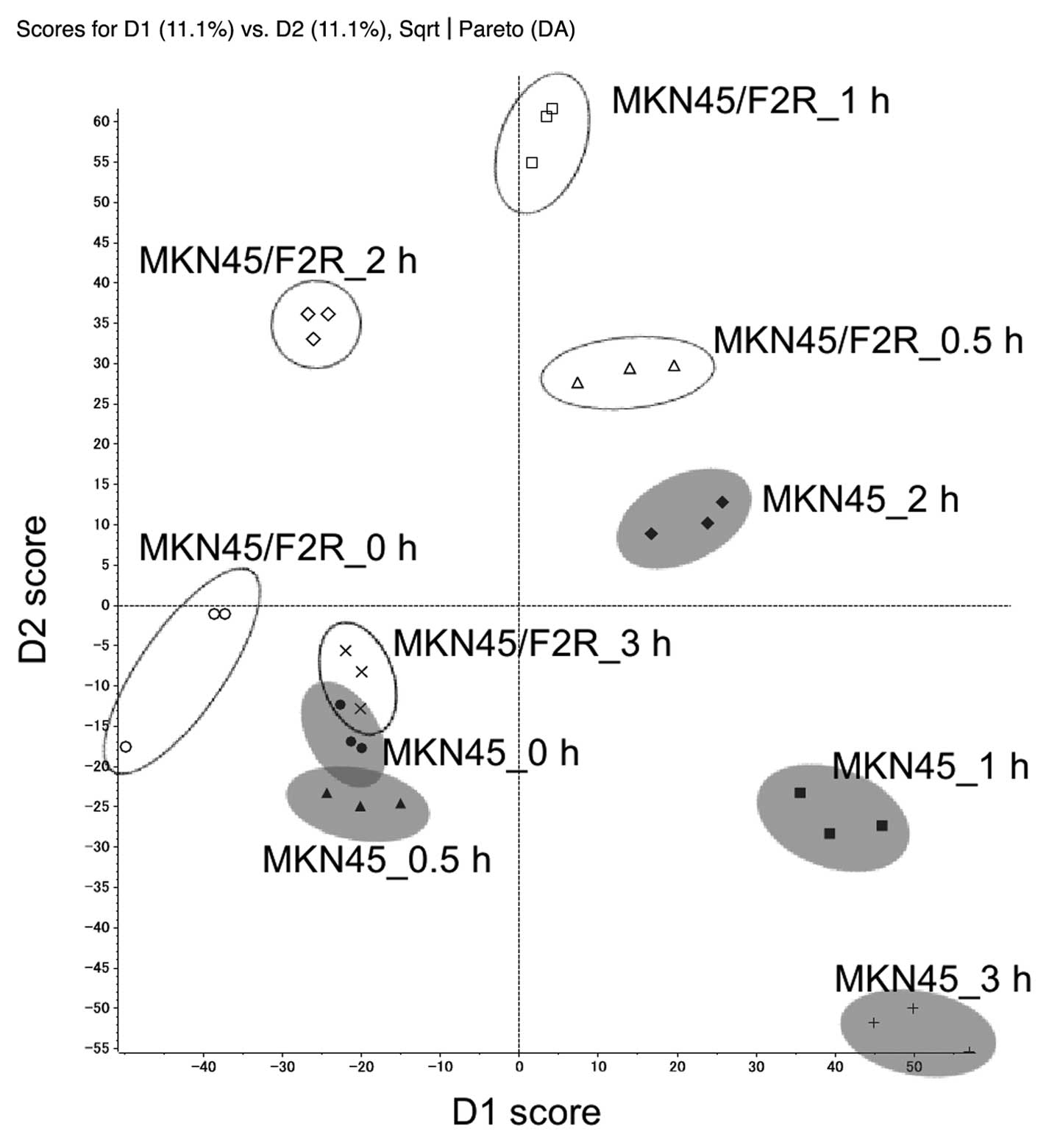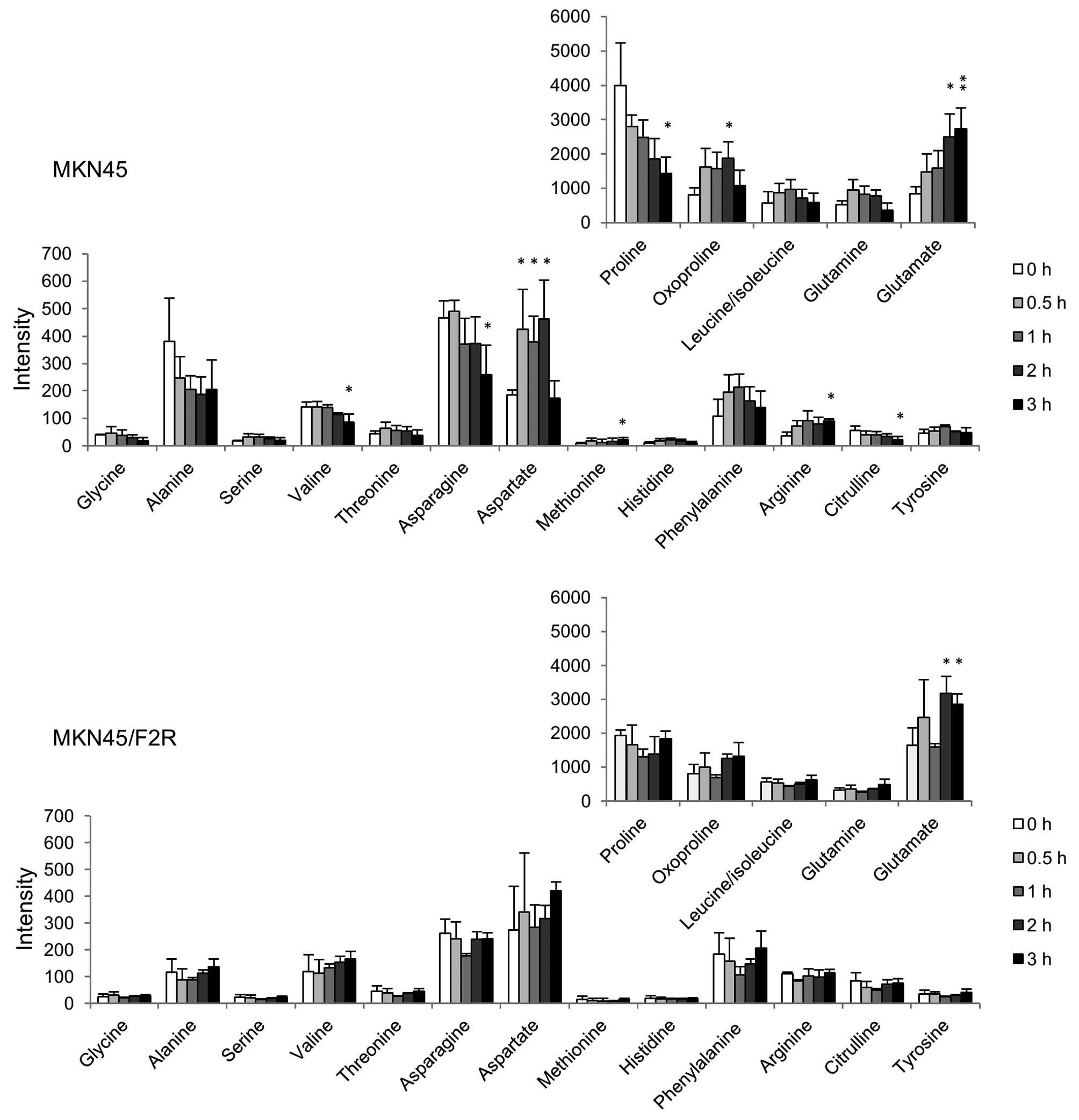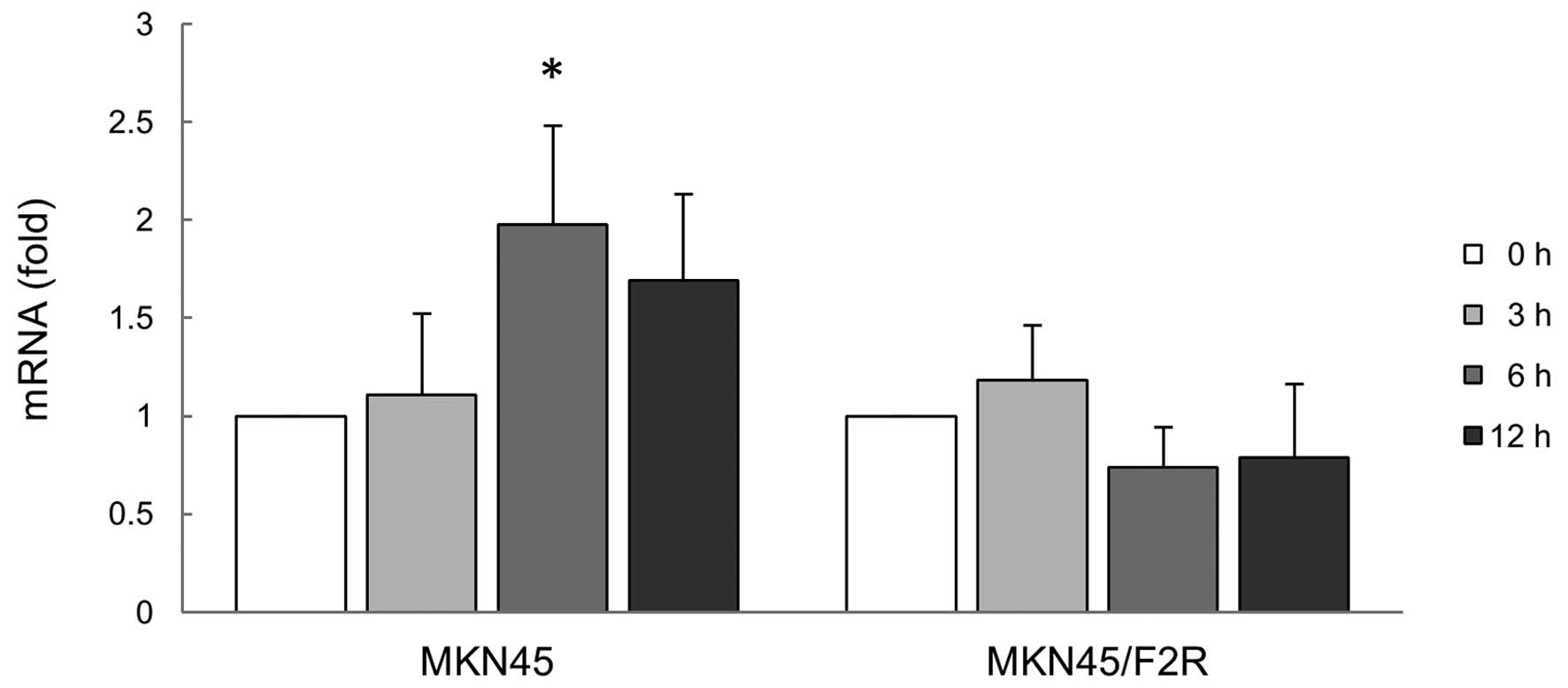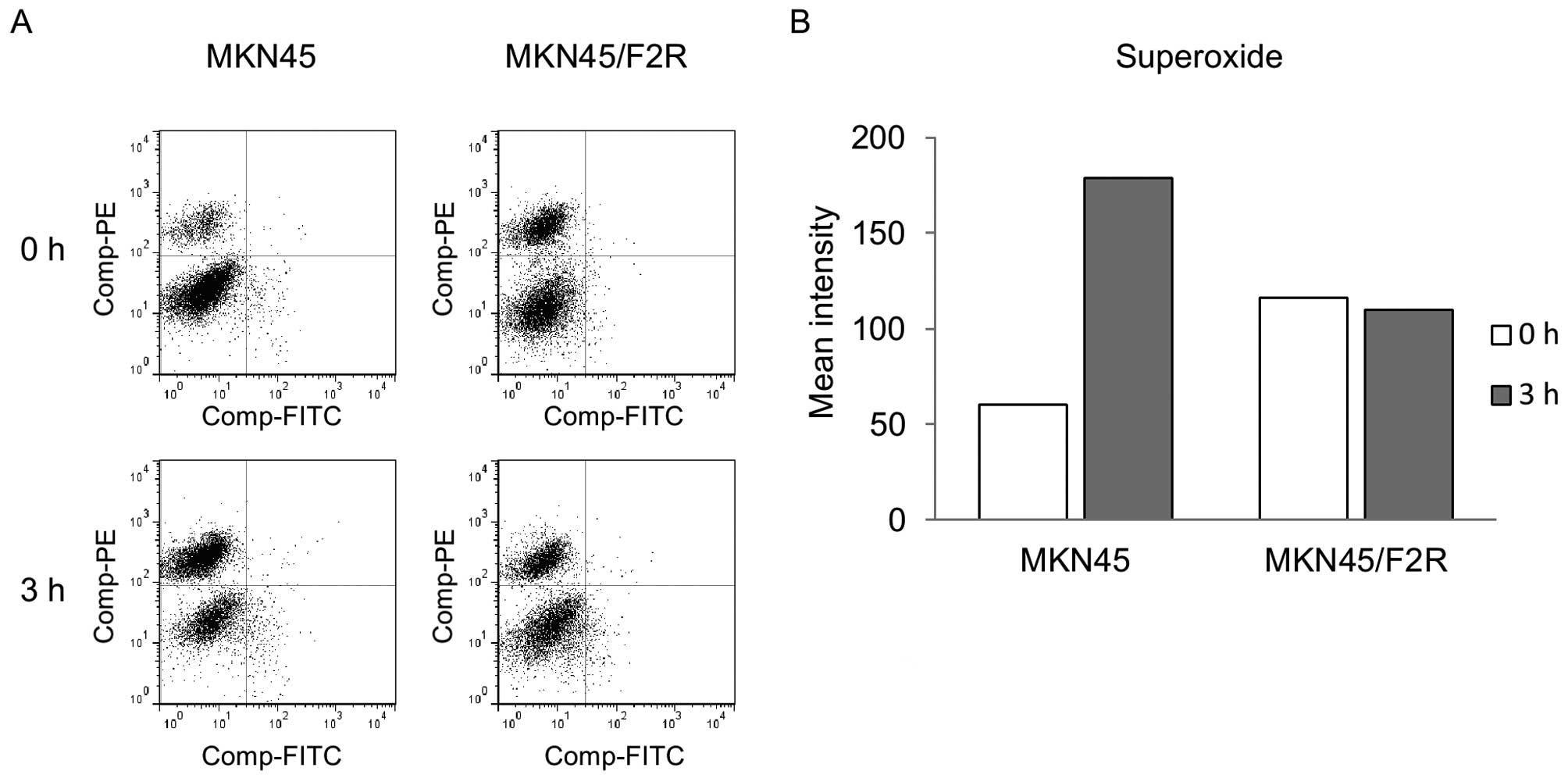Introduction
Gastric cancer is common in Asia, South America and
Eastern Europe, accounting for more than 800,000 new cases per year
worldwide. It is also the second most common cause of
cancer-related deaths globally (1).
Several chemotherapy regimens have been established as the
first-line therapy in the treatment of advanced gastric cancer
(2–4). Nevertheless, the effectiveness of
gastric cancer chemotherapy is limited, compared with similar
treatment for other malignancies, such as colorectal cancer and
breast cancer. Therefore, in order to improve the effectiveness of
chemotherapy for this cancer, it is important to investigate the
cellular responses and resistance mechanisms associated with
anticancer agents.
To investigate these topics, we turned to
metabolomics, which is considered the third pillar of systems
biology, after genomics and proteomics, representing the end of the
biochemical cascade (5).
Well-recognized tools of metabolomics include gas
chromatography-mass spectrometry (6), liquid chromatography-mass spectrometry
(LC-MS) (7) and nuclear magnetic
resonance (8). This is a novel
perspective, and the comprehensive investigation of metabolic
alterations in malignancies has rarely been conducted, in contrast
to the well-studied genomics and proteomics fields. Moreover, only
a few experiments investigating the cellular responses to
chemotherapy have been reported (9–11).
Herein, we applied the LC-MS method to investigate
the cellular response of gastric cancer cells to 5-fluorouracil
(5-FU). We observed short-term reactions and the dynamic responses
to assess the effect of the anticancer agent. In addition, we
established a 5-FU-resistant cell line, MKN45/F2R, by subjecting
the human gastric cancer cell line MKN45 to continuous 5-FU
exposure (12). We also
investigated the mechanisms of drug resistance, comparing 2 cell
lines, and identified a factor, proline dehydrogenase (PRODH), that
induces superoxide and is involved in the action and resistance of
5-FU. This is the first study highlighting a short-term, cellular,
dynamic response of gastric cancer cells and the resistance
mechanism to an anticancer agent by using the metabolomics
approach.
Materials and methods
Chemicals and solutions
High-performance liquid chromatography (HPLC)-grade
methanol and formic acid were purchased from Kanto Chemical (Tokyo,
Japan). 5-FU was purchased from Kyowa Hakko (Tokyo, Japan).
Cell culture and treatment
Human poorly differentiated gastric adenocarcinoma
MKN45 cells were purchased from the American Type Culture
Collection and maintained in RPMI-1640 medium, supplemented with
10% fetal bovine serum, 100 U/ml penicillin, and 100 μg/ml
streptomycin in a humidified atmosphere of 5% CO2 at
37°C. 5-FU-resistant MKN45/F2R cells were maintained in a culture
medium containing 2 μM 5-FU. To eliminate the effects of 5-FU in
our experiments, the resistant cells were cultured in a drug-free
medium for at least 2 weeks before any procedure. Each cell line
was planted in 6-well plates at a density of 1×106 per
well. Cells were exposed to 10 μM 5-FU or medium alone (control
group, 0 h). At specified times (up to 12 h after the onset of
treatment), cells were rinsed 3 times with phosphate-buffered
saline (PBS) and harvested by trypsinization.
Cell proliferation assay
Gastric cancer cells were seeded onto 96-well plates
(1×104 cells/well). After 24 h, the cells were treated
with various concentrations of 5-FU in 100 μl medium and incubated
at 37°C in an atmosphere of 5% CO2. After the 72-h
incubation period, CellTitler 96® Aqueous One Solution
(Promega, Madison, WI, USA) was added (20 μl/well) and the
resultant mixture was incubated for 1 h at 37°C in an atmosphere of
5% CO2. Then, the absorbance at 490 nm with a reference
at 650 nm was measured with an Emax microplate reader (Molecular
Devices, Tokyo, Japan).
LC-MS
Harvested cells were transferred to a 1.5-ml conical
tube and spun down. Cells were then washed with PBS once. Excess
PBS was removed by aspiration, and the cell pellets were suspended
in methanol (100 μl/106 cells), followed by sonication.
The samples were then centrifuged at 10,000 × g at 4°C for 10 min,
and supernatants were dispensed and stocked at −40°C.
For LC separation, a binary gradient HPLC system
consisting of an LC-20AD pump coupled to an SIL-20AC autosampler
(Shimadzu, Kyoto, Japan) with the sample cooler set at 4°C was
used. Chromatographic reversed-phase separations were performed on
an L-column2 ODS (1.5×150 mm, 5 μm) (CERI, Tokyo, Japan), operated
at room temperature. The mobile phases used consisted of purified
water containing 0.1% formic acid as solvent A, and methanol
containing 0.1% formic acid as solvent B. The flow-rate gradient
and buffer composition were produced as follows: 0–1 min, held at
3% solvent B using a flow rate of 60 μl/min; 1–3 min, linear flow
rate gradient from 60 to 20 μl/min; 3–6 min, held at 20 μl/min;
6–16 min, linear gradient of buffer composition from 3 to 99%
solvent B and of flow rate from 20 to 60 μl/min; 16–45 min, held at
99% solvent B; 45–57 min, back to 3% solvent B and re-equilibrated
for 12 min using a flow rate of 170 μl/min.
Mass spectrometry experiments were carried out on a
QSTAR Elite, a hybrid quadrupole time-of-flight instrument attached
to a Turboionspray electrospray ionization source (AB SCIEX,
Framingham, MA, USA) working on positive-ion mode. The LC eluate
was ionized at a spray voltage of 4.5 kV. We used
information-dependent acquisition in data-acquisition software
Analyst QS to obtain both full-scan spectra of m/z 50–1000
and MS/MS spectra of automatically detected peaks. Then, mass
spectra were analyzed using Marker View software version 1.2 (AB
SCIEX) to perform peak extraction, data alignment with LC retention
time, normalization by total peak area, and statistical
analyses.
Reverse transcription-polymerase chain
reaction (RT-PCR)
Total RNA was isolated using an RNeasy Mini kit
(Qiagen, Chatsworth, CA, USA) and reverse transcribed with a
Transcriptor First-Strand cDNA Synthesis kit (Roche, Tokyo, Japan).
PCRs were performed with KOD FX (Toyobo, Osaka, Japan) and GeneAmp
PCR System 9700 (Applied Biosystems, Tokyo, Japan). The specific
primers for PRODH were: forward, 5′-CGGAGAGCAGGAGCAGAGGCTTTGA-3′;
reverse, 5′-GCCGTGGACAGCGGGACGAA-3′. Glyceraldehyde-3-phosphate
dehydrogenase (GAPDH) was amplified as a loading control with the
following primers: forward, 5′-ACCA CAGTCCATGCCATCAC-3′; reverse,
5′-TCCACCACCC TGTTGCTGTA-3′. The PCR profile was 94°C for 2 min, 35
cycles at 98°C for 10 sec, 60°C for 30 sec, and 68°C for 30 sec.
All reaction products (10 μl with glycerol loading buffer) were run
on a 1% agarose gel and stained with ethidium bromide. Data were
normalized to GAPDH.
Reactive oxygen species (ROS)/superoxide
measurement
To measure intracellular ROS and superoxide, a Total
ROS/Superoxide detection kit (Enzo Life Sciences, Farmingdale, NY,
USA) was used. Cells were stained for 30 min at 37°C in the dark
with 1 μM of ROS and superoxide-sensitive fluorescent dyes, and
subsequently assayed by flow cytometry FACSAria II (BD Biosciences,
San Jose, CA, USA). Double staining with fluorescein isothiocyanate
and phycoerythrin was carried out, and data were assessed by FlowJo
software version 7.6 (Tomy Digital Biology Co., Tokyo, Japan).
Statistical analyses
Data for metabolites and mRNA expression were
calculated and expressed as the mean ± standard deviation (SD) from
at least 3 experiments. Statistical analysis of LC-MS data on
Marker View 1.2 consisted of principal component analysis (PCA)
with Pareto scaling and Student's t-test. For the mRNA experiments,
a t-test was performed using Microsoft Excel.
Results
Drug sensitivity of gastric cancer cell
lines
MKN45/F2R cells were more resistant to 5-FU than
were MKN45 cells (Fig. 1). The
IC50 of MKN45 and MKN45/F2R cells were 23.8 and 161 μM,
respectively. Growth in the absence of 5-FU was not appreciably
different between the 2 cell lines (data not shown). In subsequent
experiments, a drug concentration of 10 μM was used to examine the
effects of a larger difference.
Metabolome analysis
The LC-MS analysis yielded the raw data, detecting
7107 (MKN45) and 5696 (MKN45/F2R) peaks. Among these, the numbers
of peaks that increased by more than double their original size
after 5-FU treatment were 642 (MKN45) and 140 (MKN45/F2R), and the
numbers of peaks that decreased to less than half of their original
size were 285 (MKN45) and 18 (MKN45/F2R). The identified
metabolites are listed in Table I.
Most of the peaks were identified as endogenous metabolites, such
as amino acids, organic acids, lipids, and purines. To determine
whether these spectra contained unique peaks that could
differentiate the metabolic responses of the 2 cell lines, PCA was
performed (Fig. 2). Each
treatment-period group was clustered and separated from other
groups, and the resultant data indicated the characteristic
metabolic profiles of the cellular responses to 5-FU.
 | Table IMetabolites identified from gastric
cancer cells by LC-MS/MS study. |
Table I
Metabolites identified from gastric
cancer cells by LC-MS/MS study.
| Molecule | Formula | m/z | RT (min) | MS fragments
(m/z) |
|---|
| Glycine |
C2H5NO2 | 76.04 | 6.09 | |
| Alanine |
C3H7NO2 | 90.05 | 6.23 | |
| Serine |
C3H7NO3 | 106.05 | 6.16 | 60 |
| Creatinine |
C4H7N3O | 114.07 | 5.7 | |
| Proline |
C5H9NO2 | 116.07 | 6.64 | 70 |
| Guanidinoacetate |
C3H7N3O2 | 118.06 | 6.06 | 72, 76, 101 |
| Valine |
C5H11NO2 | 118.09 | 6.6 | 72 |
| Threonine |
C4H9NO3 | 120.07 | 6.31 | 56, 74, 102 |
| Cysteine |
C3H7NO2S | 122.03 | 6.43 | 76 |
| Oxoproline |
C5H7NO3 | 130.05 | 6.42 | 84 |
| Creatine |
C4H9N3O2 | 132.08 | 6.36 | 90 |
|
Leucine/Isoleucine |
C6H13NO2 | 132.10 | 11.22 | 86 |
| Asparagine |
C4H8N2O3 | 133.06 | 6.45 | 74, 87, 116 |
| Aspartate |
C4H7NO4 | 134.04 | 6.57 | 70, 74, 88 |
| Adenine |
C5H5N5 | 136.06 | 6.6 | 81, 119 |
|
4-Guanidinobutanoate |
C5H11N3O2 | 146.09 | 6.48 | |
|
γ-Butyrobetaine |
C7H15NO2 | 146.11 | 5.7 | 60, 87 |
| Glutamine |
C5H10N2O3 | 147.08 | 6.25 | 84, 130 |
| Glutamate |
C5H9NO4 | 148.06 | 6.4 | 84, 102, 130 |
| Methionine |
C5H11NO2S | 150.06 | 8.76 | 104, 133 |
| Histidine |
C6H9N3O2 | 156.08 | 5.67 | 110 |
| Carnitine |
C7H15NO3 | 162.11 | 5.7 | 60, 85, 103 |
| Phenylalanine |
C9H11NO2 | 166.09 | 18.47 | 120 |
| Arginine |
C6H14N4O2 | 175.12 | 5.71 | 60, 70, 116, 130,
158 |
| Citrulline |
C6H13N3O3 | 176.10 | 6.26 | 70, 113, 159 |
| Tyrosine |
C9H11NO3 | 182.08 | 11.53 | 136, 165 |
| Phosphocholine |
C5H15NO4P | 184.07 | 6.24 | 86, 125 |
| Glucose |
C6H12O6 | 203.05 | 6.08 | |
|
Acetylcarnitine |
C9H18NO4 | 204.12 | 6.62 | 85, 145 |
|
Propionylcarnitine |
C10H19NO4 | 218.13 | 6.74 | 85, 159 |
| Pantothenate |
C9H17NO5 | 220.12 | 26.68 | 72, 90, 202 |
| Lumichrome |
C12H10N4O2 | 243.09 | 31.87 | 172, 198 |
|
L-Argininosuccinate |
C10H18N4O6 | 291.13 | 6.28 | |
|
5′-Methylthioadenosine |
C11H15N5O3S | 298.10 | 28.11 | 136 |
|
Ketosphingosine |
C18H35NO2 | 298.27 | 33.07 | 282 |
| Sphingosine |
C18H37NO2 | 300.29 | 33.67 | 252, 282 |
| Sphinganine |
C18H39NO2 | 302.31 | 33.97 | |
| Glutathione |
C10H17N3O6S | 308.09 | 9.98 | 179 |
|
N-Acetylneuraminate |
C11H19NO9 | 310.11 | 8.76 | 121, 167, 274,
292 |
|
Phytosphingosine |
C18H39NO3 | 318.30 | 33.6 | 282 |
|
Palmitoylcarnitine |
C23H45NO4 | 400.34 | 35.55 | 85 |
We then attempted to identify the responsible
molecules that could serve as markers for 5-FU response. For those
differential molecules, a time course validation of major amino
acids is shown in Fig. 3. We found
that the fluctuation for MKN45/F2R was less than that for MKN45
cells. In MKN45, the amino acids increasing at 3 h were glutamate,
methionine and arginine, while those decreasing at 3 h were
proline, valine, asparagine and citrulline. The transiently altered
amino acids were oxoproline and aspartate. On the other hand, in
MKN45/F2R cells, only glutamate increased at 3 h. In particular,
proline and glutamate were very abundant and closely related in
this metabolic pathway. In MKN45 cells, proline was reduced to
one-third of its original value, and glutamate was increased to 3
times its original value after 3 h of treatment. These results
suggest that the metabolic enzymes associated with the differential
metabolites played an important role in the response to treatment
and may be behind the mechanism of resistance to 5-FU. Among these
enzymes, PRODH is particularly important; it catalyzes the first
and the rate-limiting step of 2 reactions converting proline to
glutamate at the mitochondria, and the catabolism of proline
produces superoxide.
Upregulation of PRODH mRNA and
ROS/superoxide generation after 5-FU treatment
We then investigated the amount that PRODH gene
expression was altered in response to 5-FU stimulation. A
significant increase in the concentration of PRODH mRNA was
observed in MKN45 cells after 6 h of treatment (Fig. 4). The expression of PRODH mRNA
peaked after 6 h of treatment, resulting in a 2-fold increase in
the PRODH transcript level. In MKN45/F2R cells, PRODH mRNA
expression did not vary over time.
In general, proline catabolism first produces a
superoxide anion with the chemical formula
O2−, which is subsequently changed into a
variety of ROS. Therefore, we not only highlighted ROS, but also
superoxide. We found that both MKN45 and MKN45/F2R cells produced
more superoxide than ROS, and MKN45/F2R produced more superoxide
than MKN45 at the baseline. In MKN45 cells, the shift to the upper
left quadrant was recognized, indicating the increased superoxide
generation. In MKN45 cells, the mean fluorescence intensity of
superoxide increased 3-fold following 3 h of treatment, while in
MKN45/F2R, the intensity did not increase (Fig. 5).
Discussion
In this study, we focused on small-molecule
metabolites to investigate the characteristics of cancer cells and
the cellular response to 5-FU. While there have been some
metabolomic reports on the comparison between cancer and normal
tissue (13), cancer metastasis
(14), and the cancer response to
chemotherapy (9–11), to our knowledge, this is the first
metabolomics-based study of the short-term, cellular, dynamic
response of gastric cancer cells and the resistance mechanisms to
an anticancer agent.
A previous study proposed a metabolic workflow for
the LC-MS/MS platform (15). In
this scheme, the first step is sample handling, followed by
analytical treatment, quality assessment and multivariate analysis,
data reduction by principal component variable grouping and groups
interpretation, listing of candidates (biomarkers), and finally,
biomarker identification. We followed virtually the same workflow
with our method. Candidates were searched in the metabolomics
database KEGG (16), and MS/MS
spectral searches were carried out on MassBank (17). Since even mass accuracy below 1 ppm
would generate large lists of potential biomarkers, further MS/MS
data were mandatory for structural confirmation. In general,
multivariate analysis plays a key role in metabolomics for the
comparison of large sets of data from various samples. In the case
of LC-MS, metabolomics data processing generates a large amount of
features consisting of retention time and m/z. Pattern
recognition tools, such as PCA, show covariation between
metabolites, with metabolism global trends retaining the largest
part of the information (18).
Previously, researchers have focused more on cancer
metabolism because of the realization that cancer genomics can be
understood on the basis of metabolic pathways (19,20).
However, little attention has been given to amino acids as
substrate for energetics or as mediators of cellular signaling
(21). Tumor cells require large
amounts of nutrients, including amino acids, for rapid growth and
uncontrolled proliferation, leading to perturbations in the amino
acid metabolism of cancer (22).
In this study, the intracellular metabolites of
gastric cancer cells dynamically changed within a few hours
following 5-FU treatment. In particular, several amino acids were
dramatically up or downregulated. Among these, we highlighted 2,
proline and glutamate, since they were abundant and were
continuously altered in MKN45 cells following 5-FU treatment.
Additionally, the percentage of amino acids in the medium remained
virtually unchanged after treatment (data not shown). This
indicates that both proline and glutamate were metabolized within
cells instead of being taken up into cells.
We additionally analyzed the molecule PRODH, also
known as proline oxidase, a mitochondrial inner membrane enzyme
that catalyzes the first step of proline degradation (23). In this process, proline is converted
to glutamate through an intermediate, pyrroline-5-carboxylate
(P5C). The function of PRODH is to catalyze the rate-limiting,
2-electron oxidation of proline to P5C, and the pair of electrons
can then be used for direct reduction of oxygen to form superoxide
(24). The superoxide is then
transformed to ROS, a molecule related to cell death. PRODH has
been found to be upregulated by p53, peroxisomal
proliferator-activated receptor γ, and metabolic stress (21,25,26).
Although PRODH expression levels were found to be much lower in
several types of cancers, including stomach cancer, as compared to
normal tissues (27), the
relationship between PRODH and the anticancer effect of 5-FU has
yet to be elucidated.
The present study demonstrated the upregulation of
PRODH mRNA expression and superoxide generation in the gastric
cancer cell line MKN45 following 5-FU treatment. This result
indicates that 5-FU induces the PRODH gene directly or indirectly
and stimulates the generation of mitochondrial superoxide,
following cell death. In fact, PRODH mRNA expression was slower
than the production of superoxide. In one potential explanation for
these results, PRODH activity might first be stimulated by 5-FU,
and the secondary gene expression might then be induced. The PRODH
enzyme activity may be expressed as the ratio of proline to P5C.
However, in this study, P5C could not be fully detected. The
explanation for this result was thought to be that P5C was present
at too small levels to be detectable or that it was an acidic
substance. Thus, more sensitive measurements or the negative ion
mode assay may be necessary.
Another mechanism of cell death may involve
hypoxia-inducible factor-1α (HIF-1α) and vascular endothelial
growth factor (VEGF) (21,27). PRODH produces P5C, which can then be
converted to glutamate and α-ketoglutarate (α-KG). Since α-KG is
not only a central substrate of the tricarboxylic acid cycle, but
also a critical substrate for prolyl hydroxylase (PHD), HIF-1α may
be downregulated by PHD activity. The expression levels of HIF-1α
and its downstream gene, VEGF, have been shown to be reduced by
PRODH (27).
We also investigated the mechanism of resistance to
5-FU using 5-FU-resistant cells. Specifically, we studied
MKN45/F2R, which is a 5-FU-resistant cell line derived from MKN45
gastric cancer cells (12). The
decrease in orotate phosphoribosyltransferase (OPRT), which
metabolizes 5-FU to 5-fluorouridine monophosphate, plays an
important role in the resistance to 5-FU chemotherapy (12). However, MKN45/F2R cells show
cross-resistance to other agents, such as taxanes, platinum agents
and SN38. In addition, OPRT-knockout MKN45 cells were found to be
more resistant than were MKN45 cells (12). This indicates that other factors
correlate with drug resistance. Although several candidate genes
were identified, the mechanism of resistance is not well known. In
the current metabolome analysis, fewer amino acids in MKN45/F2R
cells showed change than in MKN45 cells following 5-FU treatment.
This lower rate of effect can be traced to drug resistance. Since
PRODH mRNA expression and superoxide generation in MKN45/F2R cells
were not upregulated following 5-FU treatment, we can conclude that
PRODH may be involved in drug resistance. The present study
suggests that the inhibition of DNA or RNA synthesis by 5-FU and
the resultant genetic stress induces PRODH activity following
mitochondrial superoxide generation, represented as changes in
metabolites.
The metabolomics approach to cancer research is
still in a challenging phase despite advances in metabolomic
techniques used in various scientific fields. We performed a
metabolomic analysis of the effect of 5-FU treatment on human
gastric cancer cells, including a detailed study of the mechanism
of action of the agent. In the future, confirmation of the
prominent metabolic pathways deduced from metabolomics should be
achieved by enzyme tests, reverse transcriptomics, or genomics
(11). Our results were consistent
with metabolomic and reverse transcriptomic analyses, and show that
metabolomics can serve as an important tool in cancer research.
Acknowledgements
This study was partly supported by Grants-in-Aid for
Scientific Research (KAKENHI) (nos. 18659405 and 19591627) from the
Ministry of Education, Culture, Sports, Science and Technology,
Japan, and by Tsuchiya Foundation Scholarship and Takeda Science
Foundation Scholarship. This work was carried out at the Analysis
Center of Life Science, Natural Science Center for Basic Research
and Development, Hiroshima University.
References
|
1
|
Jemal A, Siegel R, Ward E, et al: Cancer
statistics, 2006. CA Cancer J Clin. 56:106–130. 2006. View Article : Google Scholar
|
|
2
|
Koizumi W, Narahara H, Hara T, et al: S-1
plus cisplatin versus S-1 alone for first-line treatment of
advanced gastric cancer (SPIRITS trial): a phase III trial. Lancet
Oncol. 9:215–221. 2008. View Article : Google Scholar : PubMed/NCBI
|
|
3
|
Cunningham D, Starling N, Rao S, et al:
Capecitabine and oxaliplatin for advanced esophagogastric cancer. N
Eng J Med. 358:36–46. 2008. View Article : Google Scholar : PubMed/NCBI
|
|
4
|
Van Cutsem E, Moiseyenko VM, Tjulandin S,
et al: Phase III study of docetaxel and cisplatin plus fluorouracil
compared with cisplatin and fluorouracil as first-line therapy for
advanced gastric cancer: a report of the V325 Study Group. J Clin
Oncol. 24:4991–4997. 2006.PubMed/NCBI
|
|
5
|
Sumner LW, Mendes P and Dixon RA: Plant
metabolomics: large-scale phytochemistry in the functional genomics
era. Phytochemistry. 62:817–836. 2003. View Article : Google Scholar : PubMed/NCBI
|
|
6
|
Schauer N, Semel Y, Roessner U, et al:
Comprehensive metabolic profiling and phenotyping of interspecific
introgression lines for tomato improvement. Nat Biotechnol.
24:447–454. 2006. View
Article : Google Scholar : PubMed/NCBI
|
|
7
|
Plumb R, Granger J, Stumpf C, Wilson ID,
Evans JA and Lenz EM: Metabonomic analysis of mouse urine by
liquid-chromatography-time of flight mass spectrometry (LC-TOFMS):
detection of strain, diurnal and gender differences. Analyst.
128:819–823. 2003. View
Article : Google Scholar : PubMed/NCBI
|
|
8
|
Opstad KS, Bell BA, Griffiths JR and Howe
FA: An assessment of the effects of sample ischaemia and spinning
time on the metabolic profile of brain tumour biopsy specimens as
determined by high-resolution magic angle spinning (1)H NMR. NMR
Biomed. 21:1138–1147. 2008. View
Article : Google Scholar : PubMed/NCBI
|
|
9
|
Bayet-Robert M, Loiseau D, Rio P, et al:
Quantitative two-dimentional HRMAS 1H-NMR
spectroscopy-based metabolite profiling of human cancer cell lines
and response to chemotherapy. Magn Reson Med. 63:1172–1183.
2010.PubMed/NCBI
|
|
10
|
Bayet-Robert M, Lim S, Barthomeuf C and
Morvan D: Biochemical disorders induced by cytotoxic marine natural
products in breast cancer cells as revealed by proton NMR
spectroscopy-based metabolomics. Biochem Pharmacol. 80:1170–1179.
2010. View Article : Google Scholar
|
|
11
|
Morvan D and Demidem A: Metabolomics by
proton nuclear magnetic resonance spectroscopy of the response to
chloroethylnitrosourea reveals drug efficacy and tumor adaptive
metabolic pathways. Cancer Res. 67:2150–2159. 2007. View Article : Google Scholar
|
|
12
|
Tsutani Y, Yoshida K, Sanada Y, et al:
Decreased orotate phosphoribosyltransferase activity produces
5-fluorouracil resistance in a human gastric cancer cell line.
Oncol Rep. 99:2268–2273. 2008.
|
|
13
|
Hirayama A, Kami K, Sugimoto M, et al:
Quantitative metabolome profiling of colon and stomach cancer
microenvironment by capillary electrophoresis time-of-flight mass
spectrometry. Cancer Res. 69:4918–4925. 2009. View Article : Google Scholar : PubMed/NCBI
|
|
14
|
Chen JL, Tang HQ, Hu JD, et al:
Metabolomics of gastric cancer metastasis detected by gas
chromatography and mass spectrometry. World J Gastroenterol.
16:5874–5880. 2010. View Article : Google Scholar : PubMed/NCBI
|
|
15
|
Mohamed R, Varesio E, Ivosev G, et al:
Comprehensive analytical strategy for biomarker identification
based on liquid chromatography coupled to mass spectrometry and new
candidate confirmation tools. Anal Chem. 81:7677–7694. 2009.
View Article : Google Scholar
|
|
16
|
Ogata H, Goto S, Sato K, Fujibuchi W, Bono
H and Kanehisa M: KEGG: Kyoto encyclopedia of genes and genomics.
Nucleic Acids Res. 27:29–34. 1999. View Article : Google Scholar
|
|
17
|
Horai H, Arita M, Kanaya S, et al:
MassBank: A public repository for sharing mass spectral data for
life sciences. J Mass Spectrom. 45:703–714. 2010. View Article : Google Scholar : PubMed/NCBI
|
|
18
|
Griffin JL and Shockcor JP: Metabolic
profiles of cancer cells. Nat Rev Cancer. 4:551–561. 2004.
View Article : Google Scholar : PubMed/NCBI
|
|
19
|
Dang CV and Semenza GL: Oncogenic
alterations of metabolism. Trends Biochem Sci. 24:68–72. 1999.
View Article : Google Scholar
|
|
20
|
Fox CJ, Hammerman PS and Thompson CB: Fuel
feeds function: energy metabolism and the T-cell response. Nut Rev
Immunol. 5:844–852. 2005. View
Article : Google Scholar : PubMed/NCBI
|
|
21
|
Phang JM, Liu W and Zabirnyk O: Proline
metabolism and microenvironmental stress. Annu Rev Nutr.
30:441–463. 2010. View Article : Google Scholar : PubMed/NCBI
|
|
22
|
Cascino A, Muscaritoli M, Cangiano C, et
al: Plasma amino acid imbalance in patients with lung and breast
cancer. Anticancer Res. 15:507–510. 2005.PubMed/NCBI
|
|
23
|
Phang JM: The regulatory functions of
proline and pyrroline-5-carboxylic acid. Curr Top Cell Regul.
25:91–132. 1985. View Article : Google Scholar : PubMed/NCBI
|
|
24
|
White TA, Krishnan N, Becker DF and Tanner
JJ: Structure and kinetics of monofunctional proline dehydrogenase
from Thermus thermophilius. J Biol Chem. 282:14316–14327.
2007. View Article : Google Scholar : PubMed/NCBI
|
|
25
|
Liu Y, Borchert GL, Surazynski A and Phang
JM: Proline oxidase, a p53-induced gene, targets COX-2/PDE2
signaling to induce apoptosis and inhibit tumor growth in
colorectal cancers. Oncogene. 27:6729–6737. 2008. View Article : Google Scholar : PubMed/NCBI
|
|
26
|
Pandhare J, Cooper SK and Phang JM:
Proline oxidase, a proapoptotic gene, is induced by triglitazone:
evidence for both peroxisomal proliferator-activated receptor
gamma-dependent and -independent mechanisms. J Biol Chem.
281:2044–2052. 2006. View Article : Google Scholar
|
|
27
|
Liu Y, Borchert GL, Donald SP, Diwan BA,
Anver M and Phang JM: Proline oxidase functions as a mitochondrial
tumor suppressor in human cancers. Cancer Res. 69:6414–6422. 2009.
View Article : Google Scholar : PubMed/NCBI
|















